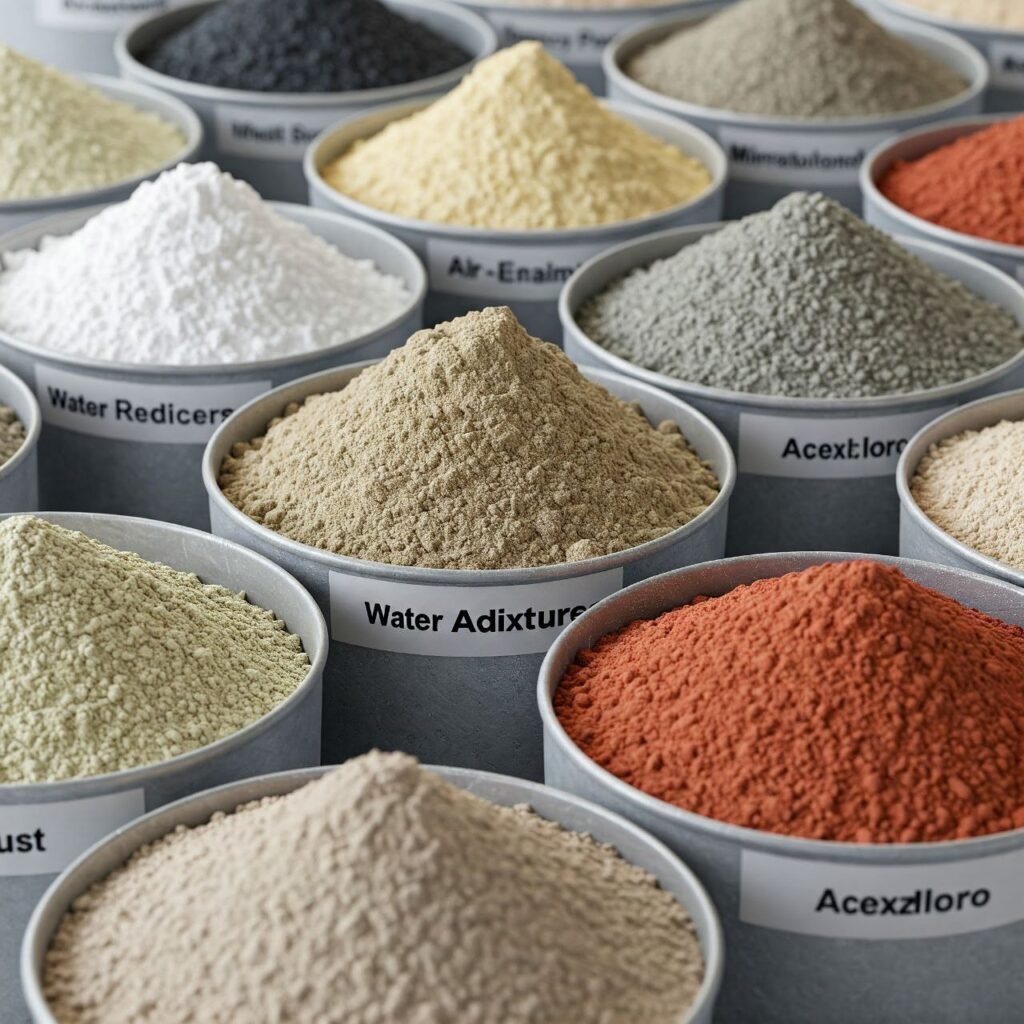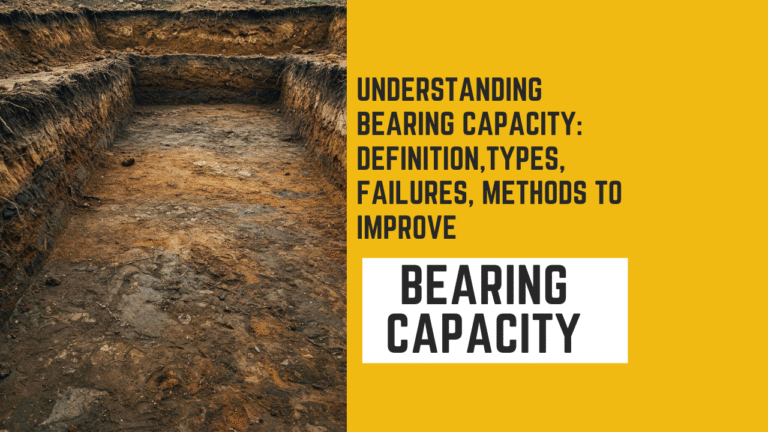Why We Add Admixture In concrete

introduction
Concrete is composed cement,sand,aggregate Additionally, admixtures may be added to modify the concrete’s properties. These can include accelerators (to speed up hardening), retarders (to slow down hardening), plasticizers (to improve workability), and others.

What Are Concrete Admixtures?
Concrete admixtures are substances added to the concrete mix during or just before mixing to alter its properties. They come in liquid or powder form and interact chemically or physically with the cement, water, and aggregates. While the basic components of concrete (cement, water, sand, and aggregate) provide a strong foundation, admixtures are the secret ingredient that enhances its performance and functionality.

Types of Concrete Admixtures
Concrete admixtures can be broadly categorized based on their function. Here’s an overview:
Water-Reducing Admixtures:
- These admixtures reduce the amount of water required in the mix without compromising workability.
- Resulting concrete has improved strength and durability.
- Commonly used in high-strength concrete for bridges, skyscrapers, and industrial facilities.
Superplasticizers:
- Also known as high-range water reducers, these provide extreme workability to the mix, making it fluid enough for complex molds or structures.
- They’re used in precast concrete, self-compacting concrete, and high-performance projects.
Accelerating Admixtures:
- These speed up the setting and hardening of concrete, essential in cold weather or projects with tight schedules
- Calcium chloride is a common accelerating agent.
Retarding Admixtures:
- Opposite to accelerators, these delay the setting time, helpful for large-scale projects to avoid joint problems.
- Useful in hot climates where concrete sets too quickly.
Air-Entraining Admixtures:
- Create microscopic air bubbles in the concrete, improving resistance to freeze-thaw cycles and enhancing durability.
- Commonly used in pavements, bridges, and structures in cold climates.
Corrosion Inhibitors:
- Protect embedded steel reinforcements from corrosion caused by chloride ions or moisture.
- Essential for marine structures, parking garages, and bridges.
Shrinkage-Reducing Admixtures:
- Mitigate shrinkage cracks during the drying process, ensuring structural integrity over time
- Common in floors, slabs, and structures requiring precision.
Silica Fume and Pozzolanic Admixtures:
- Pozzolanic materials react with calcium hydroxide, increasing strength and reducing permeability.
- Silica fume produces ultra-high-strength concrete and is used in high-performance applications.
Coloring Admixtures:
- Add pigment to concrete for decorative purposes in driveways, patios, and architectural finishes.
Anti-Washout Admixtures:
- Prevent washout in underwater concrete, ensuring stability during placement.
- Used for offshore construction and underwater repairs.

Why Use Admixtures?
The primary reasons for using concrete admixtures include:
- Enhancing Workability: In some cases, fresh concrete can be difficult to mix, place, and finish. Admixtures improve flow and handling, reducing labor intensity.
- Increasing Strength and Durability: Admixtures modify the hydration process of cement, leading to stronger and more durable concrete.
- Accelerating or Delaying Setting Time: Depending on the construction needs, admixtures can either speed up the curing process or delay it for more flexibility.
- Reducing Water Requirements: Admixtures can reduce the amount of water needed in a mix, producing stronger concrete.
- Improving Resistance to Environmental Conditions: Whether it’s resisting freeze-thaw cycles, sulfate attacks, or water seepage, admixtures can provide additional layers of protection.
- Cost Efficiency: With improved performance, less material or reinforcement may be needed, leading to cost savings.
Applications of Concrete Admixtures
Concrete admixtures are widely used across different sectors of construction due to their versatility. Here are some key applications
- Infrastructure Projects: Bridges, highways, dams, and tunnels benefit from water-reducing, air-entraining, and corrosion-inhibiting admixtures for long-lasting performance.
- Industrial and Commercial Buildings: High-rise buildings utilize superplasticizers and strength-enhancing admixtures for their load-bearing structures.
- Residential Construction: Retarding and shrinkage-reducing admixtures ensure smooth finishes and crack resistance in home floors and walls.
- Marine and Coastal Structures: Corrosion inhibitors and anti-washout admixtures are indispensable for structures exposed to seawater and harsh conditions.
- Decorative Concrete: Coloring admixtures allow architects and designers to create aesthetically pleasing patterns and textures.
Applications of Concrete Admixtures
- Infrastructure Projects:Bridges, highways, dams, and tunnels benefit from water-reducing, air-entraining, and corrosion-inhibiting admixtures for long-lasting performance.
- Industrial and Commercial Buildings:High-rise buildings utilize superplasticizers and strength-enhancing admixtures for their load-bearing structures.
- Residential Construction:Retarding and shrinkage-reducing admixtures ensure smooth finishes and crack resistance in home floors and walls.
- Marine and Coastal Structures:Corrosion inhibitors and anti-washout admixtures are indispensable for structures exposed to seawater and harsh conditions.
- Decorative Concrete:Coloring admixtures allow architects and designers to create aesthetically pleasing patterns and textures.

Advantages and Challenges of Using Admixtures
Advantages:
- Customization of concrete properties to meet diverse needs.
- Improved efficiency, reducing construction time and costs.
- Enhanced performance, durability, and sustainability.
Challenges:
- Incorrect dosing or mixing can lead to undesirable results.
- Some admixtures, like accelerators or superplasticizers, may be expensive.
- Compatibility issues between admixtures and certain cement types may arise.
Innovations in Admixtures and the Future
As technology advances, the construction industry is continually innovating admixtures to meet new challenges. Eco-friendly admixtures that lower carbon footprints are on the rise, aligning with sustainability goals. Self-healing admixtures, which enable concrete to repair its own cracks using bacteria or other agents, are another cutting-edge development.
In the future, smart admixtures may offer real-time monitoring of concrete performance during construction, ensuring optimal results.
conclusion
Concrete admixtures have revolutionized construction by providing the flexibility to adapt concrete to a wide range of applications and challenges. From improving durability in harsh environments to enabling the design of intricate structures, admixtures are the unsung heroes of modern construction. As research and development continue, we can expect admixtures to play an even more critical role in shaping the future of architecture and infrastructure.






